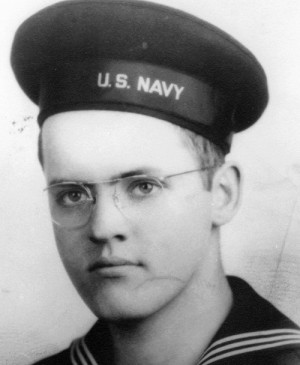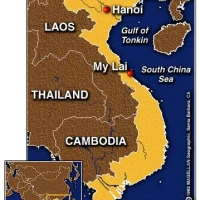WORLD WAR II FROM A TO Z

“Murderers row at Ulithi atoll” by USN – Official U.S. Navy photo no. 80-G-294131 Naval Historical Center This media is available in the holdings of the National Archives and Records Administration, cataloged under the ARC Identifier (National Archives Identifier) 520666.This tag does not indicate the copyright status of the attached work. A normal copyright tag is still required. See Commons:Licensing for more information. +/−. Licensed under Public Domain via Wikimedia Commons – http://commons.wikimedia.org/wiki/File:Murderers_row_at_Ulithi_atoll.jpg#/media/File:Murderers_row_at_Ulithi_atoll.jpg
Murderers Row. The photograph above is the Third Fleet aircraft carriers at anchor in Ulithi Atoll, 8 December 1944, during a break from operations in the Philippines area. The carriers are (from front to back): USS Wasp (CV-18), USS Yorktown (CV-10), USS Hornet (CV-12), USS Hancock (CV-19) and USS Ticonderoga (CV-14). Wasp, Yorktown and Ticonderoga are all painted in camouflage Measure 33, Design 10a. Photographed from a USS Ticonderoga plane.
The Fast Carrier Task Force was the main striking force of the United States Navy in the Pacific War from January 1944 through the end of the war in August 1945. The task force was made up of several separate task groups, each typically built around three to four aircraft carriers and their supporting vessels. The support vessels were screening destroyers, cruisers, and the newly built fast battleships.
In my other blog, USS Hornet (CV-12) – A Father’s Untold War Story, the fast carrier task force is mentioned often as this famous aircraft carrier was part of the task force.
Before the carrier, the primary striking power of the navy was its battleship force. With the carrier, the aircraft could be brought to battle. The means by which the US Navy operated these carriers was developed principally by Admiral Marc Mitscher. Mitscher determined that the best defense for a carrier was its own air groups, and that carriers were more easily defended if they operated together in groups, with supporting ships along with them to aid in air defense, anti-submarine defense, and rescue of downed airmen.
“The ideal composition of a fast-carrier task force is four carriers, six to eight support vessels and not less than 18 destroyers, preferably 24. More than four carriers in a task group cannot be advantageously used due to the amount of air room required. Less than four carriers requires an uneconomical use of support ships and screening vessels.”
— Admiral Marc Mitscher
The ships of each task group sailed in a circle formation centered on the carriers. The supporting ships sailed relatively close by, and added their anti-aircraft fire to that of the carriers to help ward off attacking aircraft. When under attack by torpedo aircraft, the task group would turn toward the oncoming aircraft to limit attack angles. Other than this measure, the carriers in the task group would not take evasive action from their attackers. This was in marked contrast with the Imperial Japanese Navy, but the choice made for more stable platforms for the anti-aircraft fire of all the ships in the task group and allowed the ships in the group to sail more closely together. The primary defense of the group against air attack was the group’s own fighter cover.
Although Admiral Mitscher was primarily responsible for the development and operations of the task force, the overall command of the task force alternated between two very different admirals: Raymond Spruance and William “Bull” Halsey. Halsey was aggressive and a risk taker. Spruance was calculating, professional and cautious. Most higher-ranking officers preferred to serve under Spruance; most common sailors were proud to serve under Halsey. Their commander was Admiral Chester Nimitz.
When the force was part of Admiral Spruance’s Fifth Fleet, it bore the designation Task Force (TF) 58. When led by Admiral William Halsey as part of the Third Fleet, its designation was Task Force (TF) 38. Planning for upcoming operations was completed when each admiral and his staff rotated out of active command. This allowed the Navy to perform at a higher operational tempo, while giving the Japanese the general impression of naval assets greater than what were actually available.
Fast carriers in action
The Fast Carrier Task Force took part in all the US Navy’s battles in the Pacific during last two years of the war. The Fast Carrier Task Force worked in conjunction with the other two major components of the Pacific Fleet, the Amphibious Force, which was much larger overall and which carried and provided direct support to the Marine forces, and the Service Squadrons of hundreds of support vessels which resupplied and maintained the fleet.
The fleet and task group designation changed when the command of the fleet changed hands. When under the umbrella of Fifth Fleet, the invasion force was called the Fifth Amphibious Force. When Halsey had command of the fleet, Third Amphibious Force was the designation. By the time of the Battle of Iwo Jima in early 1945, the Task Force included eighteen aircraft carriers, eight battleships and two battlecruisers, along with numerous cruisers and destroyers. TF 58 alone commanded more firepower than any navy in history.










 Check out my other blog
Check out my other blog I'M PUBLISHED
I'M PUBLISHED I'm Published Again
I'm Published Again









Excellent post Maryann!
LikeLike
Nice attempt at a shape poem. It does look like an aircraft carrier.
Aircraft carriers are really quite amazing. The ones now are so huge!
Arlee Bird
A to Z Challenge Co-host
Wrote By Rote
LikeLike
Thanks. One of these days I have to get out to California to go to the USS Hornet museum, my dad’s WW2 carrier
LikeLike
Really interesting post, especially about the cruising formation of the fast carrier groups.
LikeLike
You did a great job with the poem as the carrier. Great post as always
LikeLike
Thanks. The Easter Egg on Sunday was an easier shape to deal with 😏
LikeLike
I like that point about giving the Japanese the impression they had more assets than they actually did. And that’s a great job with the shape poem – you picked a challenging configuration there! 🙂
LikeLike
Yeah my Easter Egg on Sunday was much easier.
LikeLiked by 1 person
My dad missed serving in WWII, but served later in the navy and loved it. He watched all the old news reels on the war on TV faithfully. I’m thankful for the brave admirals and crews who fought so bravely to protect our country!
LikeLike
Me too. Any person who serves in the armed forces of any country deserve the greatest respect.
LikeLike
Oh, forgot to mention your poem…..I like it!!
LikeLike
Thanks.
LikeLike
Very informative as I didn’t know any of this. Either sleeping or we didn’t get taught this in English schools. Think the emphasis was heavily on European theatre,
LikeLike
We didn’t get very much detail about WW2 in school. I’ve learned a lot since researching my dad’s carrier
LikeLike